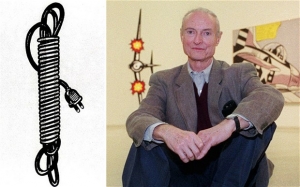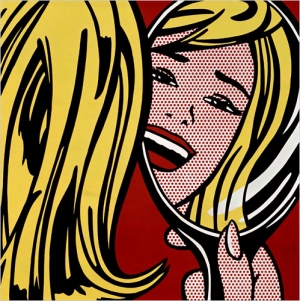|
Displaying items by tag: Lichtenstein

Roy Lichtenstein painting that disappeared 42 years ago has re-emerged in a Manhattan warehouse -- and its owner is trying to make sure it doesn't pull another disappearing act.
The estimated $4 million painting by the late pop art prince, called "Electric Cord," was last seen in 1970, when owner Leo Castelli sent it out to be professionally cleaned.
It never made it back to Castelli's apartment, and was reported lost or stolen.
It's whereabouts remained a mystery until last week, when the Roy Lichtenstein Foundation called Barbara Castelli, Leo's widow, to say it had turned up at a high-end art storage warehouse on E. 61st Street, and that someone was trying to sell it.
A rep from the foundation had gone to look at the painting after they were asked to authenticate by a Manhattan gallery boss who the "owner" had approached for a possible sale, the court papers say. The work had apparently recently been on display at a museum in Bogota.
The foundation had been trying to help Castelli located the painting for years, and immediately tipped her off, the filings say.
Now Castelli's making sure it stays in the Big Apple - she filed papers in Manhattan Supreme Court seeking an order barring Hayes Storage Warehouse releasing the painting to anyone pending a court hearing.
Castelli said in court papers that she was making the move because she's "deeply concerned" about the possibility of the artwork, "which is an American treasure by an artist native to Manhattan, again disappearing, perhaps to never be seen again."
"We do not know who's claiming to own it, or who's trying to sell it. We do not know who placed it at Hayes," said Castelli's lawyer, Perry Amsellem. But "we do know it is at Hayes . . . and we're concerned the painting is going to just disappear again."
Justice O. Peter Sherwood signed an order earlier this afternoon barring the warehouse from moving the painting until after a hearing on Monday morning with representatives from Hayes and the current "owner," who's listed on the court papers as "John Doe."

Roy Lichtenstein’s “Sleeping Girl” sold for $44.9 million at Sotheby’s in New York last night, a record for the artist, in a $266.6 million contemporary-art auction that was almost a third smaller by value than Christie’s the night before.
Records were also set for Ai Weiwei, Cy Twombly, Glenn Ligon, Mark Bradford and Isa Genzken, as 11 of the 57 lots didn’t sell.
The casualties included two paintings by Willem de Kooning, who had a recent retrospective at the Museum of Modern Art, and a photograph by Cindy Sherman, who has a solo show there now.
“It seems like there’s a lot of money chasing the trophies, but the rest of the market is tepid,” said Suzanne Gyorgy, global head of art advisory and finance at Citi Private Bank. (C) “It felt shaky.”
The night before, Christie’s achieved records for Jackson Pollock, Gerhard Richter and Alexander Calder in the biggest- ever contemporary-art auction. Just three of 59 lots failed to sell.
“Maybe people were spent out,” said Joanne Heyler, director and chief curator of the Broad Art Foundation, established by collector Eli Broad. “There wasn’t the same density of high-value lots. The market hasn’t completely lost its head.”
Dealers said Sotheby’s estimates were optimistic for a cache that was less spectacular than Christie’s, which had 13 lots from the estate of collector David Pincus that alone totaled about $175 million.
‘Freshness and Provenance’
“At the end of the day, it’s about the material, its freshness and provenance,” said David Benrimon, whose family operates three galleries in New York.
“Sleeping Girl” surpassed the high estimate of $40 million and the previous Lichtenstein record of $43.2 million, set six months ago at Christie’s.
The 3-by-3-foot image of a sultry blonde was in the collection of Phil and Beatrice Gersh, who bought it from the Ferus Gallery in Los Angeles in 1964, the year it was painted. The Gershes were founding members of the city’s Museum of Contemporary Art. Beatrice Gersh died last year. Her husband, a former talent agent, died in 2004.
“Sleeping Girl” tied for the top lot with Francis Bacon’s 1976 canvas “Figure Writing Reflected in Mirror.” That painting depicts a seated man scribbling on a white sheet of paper with his back and profile toward the viewer. The man is reflected in the mirror.

An elderly woman sued the Gagosian Gallery, claiming it allowed her son to sell a major work by pop artist Roy Lichtenstein, without her permission, for far less than its true value.
Ninety-three-year-old Jan Cowles sued Larry Gagosian and the Gagosian Gallery, in New York County Court.
She claims that her son Charles Cowles, an art dealer in New York City, sold her Lichtenstein enamel, "Girl in Mirror," out of financial desperation, while his mother suffered "moderate to severe dementia."
Charles Cowles is not a party to the case.
The complaint states: "By 2008, Charles Cowles suffered large financial losses and was in desperate financial condition. Charles's financial distress was known to Gagosian; and, in fact, the closing of Charles's gallery was reported in a large article in the 'New York Times' in June 2009, which refers to Charles Cowles Gallery as the 'most recent casualty' in the contemporary art market, and quotes Charles as commenting that '[i]t's shocking how bad business has been.'
"Unknown to Mrs. Cowles, by 2008 Charles had sold some of her art collection without her knowledge or consent and failed to remit the sale proceeds to her."
Jan Cowles says that her attorney-in-fact Lester Marks discovered what her son was doing in December 2009, and immediately hired counsel to investigate it.
"The investigation revealed two transactions between Charles and Gagosian regarding two major works of art: one involving a painting by Mark Tansey, and the other concerning the Lichtenstein work."
The Tansey work, "The Innocent Eye Test," was the subject of a similar lawsuit that Jan Cowles filed in May 2011.
Her new lawsuit, filed Wednesday, details the alleged fraud involving the $5 million Lichtenstein work at greater length.
"In or about October 2008, Gagosian somehow learned that Mrs. Cowles owned the Lichtenstein work," the complaint states. "Rather than contacting Mrs. Cowles directly, however, Gagosian chose to contact Charles Cowles to inquire as to whether Mrs. Cowles would consider selling it. Thereafter, Charles took Larry Gagosian to Mrs. Cowles's apartment at a time when she was not present to view the work. Upon closely inspecting the work (which hung prominently in the apartment) and without expressing any undue concern about its condition, Larry Gagosian represented that he could achieve a sale price of $3 million or more. In fact, Gagosian was aware, another 'Girl in Mirror' in the edition of eight had been sold almost a year and a half earlier, in May 2007, at an auction in Sotheby's for $4,072,000."

An undocumented Mark Rothko painting could fetch as much as $22 million at Christie’s in New York next month as collectors from Moscow to Qatar vie for trophy art.
“Untitled No. 17,” depicting pink and red rectangles on a tangerine-yellow background, will be offered at Christie’s postwar and contemporary art auction on May 11.
The 1961 painting, which hasn’t been seen publicly since 1965, is one of several rediscovered art works on the block this year. Christie’s is offering Roy Lichtenstein’s, “Drawing for Kiss V,” which re-emerged after decades of obscurity with an estimate range of $800,000 to $1.2 million. It was originally bought with a $10 lottery ticket in 1965.
An unpublished 1967 self-portrait by Andy Warhol fetched 10.8 million pounds ($17.4 million) at Christie’s in London earlier this year.
“Untitled No. 17” is one of 10 Rothko paintings discovered since the publication of the artist’s catalogue raisonne in 1998.
“It’s one of the very few that got away,” said David Anfam, London-based art historian and the author of “Mark Rothko: The Works on Canvas.” “It went to a private collection soon after it was made and those collectors just kept a very low profile.”
Rothko painted 22 mostly somber canvases in 1961, the year of his retrospective at the Museum of Modern Art in New York.
“This work is coming in between two milestones of his late development,” Anfam said. “He has finished the Seagram murals, and he is on the brink of getting into the Harvard murals; that’s going to be in 1962.”
|
|
|
|
|